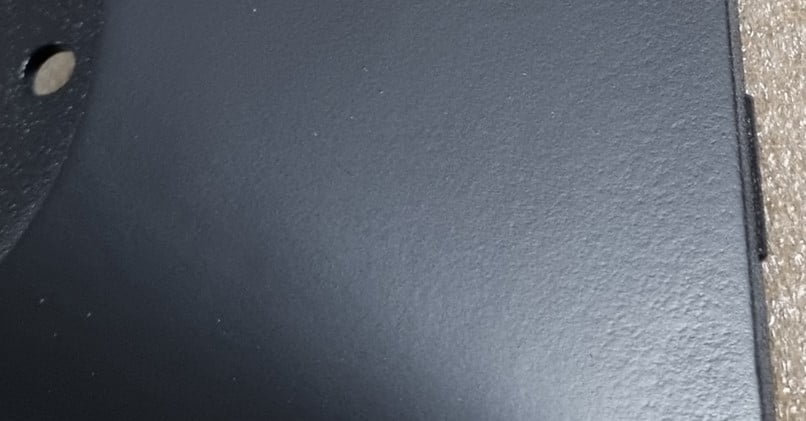Invisible vapour that changes the cosmetic appearance of solid objects would not go amiss in a science fiction story. But this is one futuristic process that’s already a contemporary standard for plastics manufacture.

Metal and plastic parts manufactured for a large market must, above all else, look appealing to the consumer. A book may be judged by its cover when a part’s cosmetic appearance is rough, non-uniform, or haphazard in quality. This problem has particularly plagued the metals industry for decades. “Smoothing”, as a technique for creating an aesthetically pleasing finish, has been utilized in the past with such practices as:
If these processes sound a bit demanding, that’s because metal is a tough cookie to smooth. Often, it requires spindles, abrasive media, and physical velocity from the metal in the case of tumbling.

SLA Vapour Smoothed
It can be difficult to determine when a smoothing process for plastics became common practice. However, it is safe to assume that along with the rise of 3D printing in the 1990s, post-processes to smooth Fused Deposition Modelling (FDM) lines from layer-by-layer printing also rose in popularity. An early method involved the modification of polymers by blasting them with energetic ions. This was called ion beam irradiation. The process was also utilised in the synthesis of chemical vapour deposition (CVD) materials such as diamond film.

Before and after vapour polished. Credit: Piedmont CMG
Using vapour to smooth plastic parts has similarly grown with the influence and commodity of 3D printing. Vapour polishing is a post-processing technique used for improving clarity and increasing transparency of a plastic surface. The technique is able to provide lens-like visibility through plastic by utilising chemical vapour that is sprayed onto a surface. It can then flow and smooth at a microscopic level. However, vapour polishing still requires a part to be pre-sanded. The process does not rid any large deviations in surface texture, such as deep ridges or scratches. Therefore, vapour polishing is usually applied to injection mould and vacuum moulded objects that show very few surface irregularities.
So why has vapour smoothing remained attractive to the plastics industry, and specifically, 3D printing?
Vapour smoothing is a chemical post-processing technique that is used to smooth the surface of a 3D printed part. This is achieved by exposing its material to a vapourised solvent in a controlled environment. The process technology enhances surface finish, allowing the plastic to flow and smooth without affecting its mechanical performance.
Vapour smoothing offers fast, high quality and repeatable results in post-processing 3D printed parts. The most accessible form of vapour smoothing for 3D printing is the combination of acrylonitrile butadiene styrene (ABS) and acetone. ABS is arguably the most common plastic found worldwide. Since the 1950s, it has been the go-to plastic for consumer products and engineering applications. Its respectable tough and durable properties have made it a competitive thermoplastic polymer in the contemporary sphere.

Acetone vapour effect on ABS. Credit: John Lewis, CC BY-SA 4.0, via Wikimedia Commons
Acetone is a chemical solvent usually found in cleaning solutions. When applied to ABS it becomes highly reactive and can dissolve the surface of ABS parts with ease. However, the smoothing process is difficult to control, with methods such as liquid acetone dipping or brushing leaving messy results. Yet, at a stable temperature of around 90oC, acetone vapour produces a respectable result in smoothing FDM lines.
At IPFL, Multi Jet Fusion (MJF) technology produces functional and complex PA12 3D printed parts. PA12 is a nylon polymer with strong mechanical properties including tensile strength, abrasion resistance, and low water absorption. Yet when printed, PA12 suffers from a rough surface finish that lacks the quality found in its mechanical properties.

Vapour smoothed HP MJF mid finish
The 3D printing revolution has increased the creation of complex and intricate designs for the manufacturing industry. IPFL’s 3D printing services span numerous sectors, including automotive, electronics, medical & pharmaceutical, life science, consumer, and industrial markets. With vapour smoothing, the chemical solvent can soften and partially dissolve the surface of MJF PA12 3D printed parts.
When coupling the post-processing technique with AMT PostPro: a digital platform that automates expensive legacy 1.0 ‘low volume and prototyping’, vapour smoothing not only improves the surface finish but also increases the strength of the final product.
Vapour smoothing is by no means a necessity for effectively marketing 3D printed parts. Nevertheless, the visible benefits in quality and performance make for a more desirable product in the consumer market. Here are five beneficial attributes of vapour smoothed 3D printed parts:
A primary advantage of vapour smoothing involves increasing the strength of a 3D printed part. The solvent vapour partially dissolves the top layer of plastic and lets it flow. This process fills in porous areas and creates a continuous dense surface that negates chances of fracture. The stronger and more durable product can then perform in the toughest and most demanding applications.

Final vapour smoothed PA12
Moreover, the melt process of vapour smoothing creates the benefit of surface sealing. The flow of thermoplastic seals the surface of the part, protecting it from environmental factors like moisture and temperature changes. This is crucial for 3D printed parts intended for harsh exposure, and ensures the final product has a long lifespan.
Additionally, with AMT PostPro, vapour smoothing meets US and EU safety standards with UL & CE marks for use of vapour smoothing in construction applications. This demonstrates the ever-expanding influence of vapour smoothing on the plastics market.
The post-processing technique is highly effective for MJF PA12 3D printed items. It improves surface finish, increases strength, and seals the surface of the final product. IPFL’s vapour smoothing ensures the final product will not only be aesthetically pleasing but durable and functional for whatever application. Now and into the future.